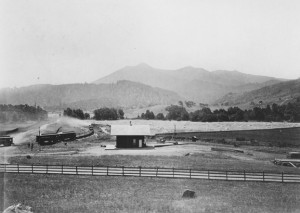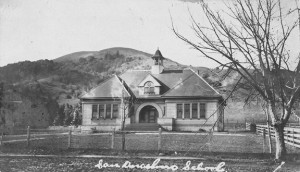Now part of the United States, San Francisco was reeling from the onslaught of the Gold Rush. San Anselmo, however, remained what it had been: pastoral. That changed in 1874 with the arrival of the North Pacific Coast Railroad, first providing service between Sausalito and San Rafael, then offering a line west to Tomales via Fairfax and the White’s Hill Tunnel. In the middle of it all was San Anselmo, the railroad’s hub.

San Anselmo (Junction), 1875
For the next decade, sleepy San Anselmo was simply known as the “Junction.” But by the 1880s, after taking its name from Cooper’s original land grant, San Anselmo was beginning to grow, thanks to real estate agents who saw the town’s potential and to the Presbyterians, who moved their seminary from San Francisco to 14 acres-the Sunnyside Tract – donated by A. W. Foster of San Rafael. Money for buildings to house the students, faculty, and the school’s well-stocked library was donated by financier and philanthropist, Alexander Montgomery.
When Montgomery and Scott Halls were dedicated in September 1892, on what was then a barren knoll, there were 20 students and six teachers. While other factors contributed to San Anselmo’s growth – notably the earthquake and fire of 1906 – the impact of the Seminary was a strong cultural, and conservative, influence on the town for most of its early history.

Montgomery & Scott Halls, 1898
As San Anselmo grew in the late 1800s, so did the need for public schools. In 1893, Alexander Bouick, groundskeeper for the Seminary, provided space at his home for a makeshift school, which did the job until the town’s first official school – simply called the San Anselmo School – opened in 1898 to serve 48 students. Located on the grounds of what is today Wade Thomas School, the school’s name was changed to Main School in 1909. The town’s second school, Lansdale, opened in 1908 near the recently built Lansdale station.

San Anselmo School, 1900
In 1900, another service for children appeared-the Presbyterian Orphanage housed in an imposing three-story building on a knoll west of Red Hill. Destroyed twice by fire, the orphanage, funded by shipping magnate Robert Dollar, was rebuilt and became Sunny Hills in 1931.

